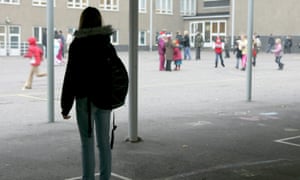
The number of permanent exclusions from schools in England has gone up, with the equivalent of 35 children being expelled every school day, according to government figures.
Almost, 6,700 children were permanently excluded from all primary, secondary and special schools in 2015/16, meaning the rate of expulsions has risen every year since 2012/13.
Of those, 1,185 were primary age children, including 475 children who were seven or under, and 50 four-year-olds.
Almost a third of primary exclusions were for assault against an adult, though the most common reason was persistently disruptive behaviour.
Figures released by the Department for Education show that the total number of exclusions went up by just under 1,000 in 2015-16 compared with the previous year – up from 5,795 in 2014/15 to 6,685 – which is the equivalent of 35.2 exclusions a day, up from an average of 30.5.
Teachers’ leaders, seeking to explain the increase, said more children were becoming disengaged from school as the curriculum narrowed, with a growing focus on testing, especially among the youngest children. They also warned about the impact of cuts to the number of teaching assistants, who often support disruptive pupils.
Pupils at secondary school account for eight in 10 of all expulsions (81%); 14-year-olds had the highest number of permanent exclusions at 1,715, with a higher exclusion rate among boys than girls.
Pupils with a black or mixed ethnic background were more likely to be excluded than their white counterparts who, in turn, were more likely to be excluded than children of Chinese and Asian heritage.
Overall, the rate of permanent exclusions is equivalent to 84 pupils per 100,000, up from 74 per 100,000 the previous year. Longer term there has been a generally downward trend since since 2006/07.
The DfE figures also show that the number of temporary or fixed-period exclusions has gone up from almost 303,000 last year to just under 340,000, with increases in both primary and secondary schools.
There was an increase in the proportion of children temporarily excluded in every age group other than among 17-year-olds. However, the rate of exclusion among those aged four and under grew at a faster rate than any other age category, rising from 2,350 in 2014-15 to 3,035 last year.
Figures show that almost 25,000 children aged seven or under were temporarily excluded from primary school in 2015/16. More than 15,000 fixed-period exclusions in primary school were for physical assault against an adult. The average length of a fixed suspension was 2.2 days.
Commenting on the figures, Kevin Courtney, general secretary of the National Union of Teachers, said: “This is a concerning trend and the DfE must give serious and honest consideration to what is driving these rising numbers of exclusions.
“NUT members tell us that as the curriculum gets narrower and children’s experience of school is ever more focused on preparation for tests and exams, more students are becoming disengaged from school which in turn leads to problems with behaviour and mental health problems.
“Cuts to school and local authority budgets have led to pastoral and mental health support services being scaled back or axed. Some schools have had to reduce the number of teaching assistants employed. This clearly has an impact on the help schools can give to individual pupils as and when the need arises.”
A DfE spokeswoman said: “We want every child to have access to a good school place where they can learn without disruption and feel safe at school.
“The rules are clear that exclusion powers should only be used in particular circumstances and decisions to exclude should be lawful, reasonable and fair. Permanent exclusion should only be used as a last resort, in response to a serious breach, or persistent breaches, of the school’s behaviour policy.”
[Source”pcworld”]

